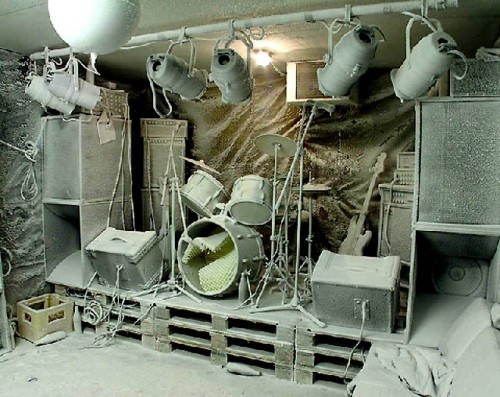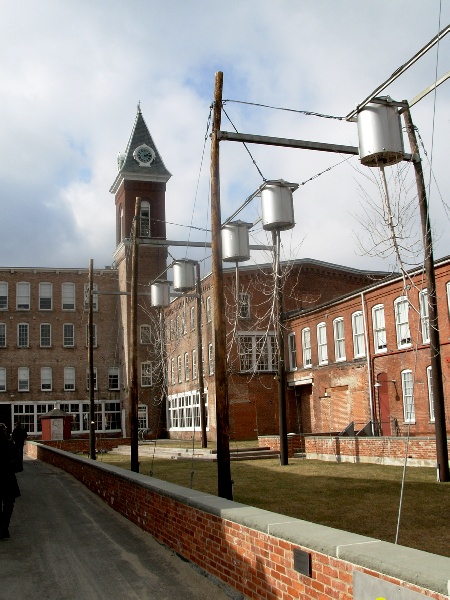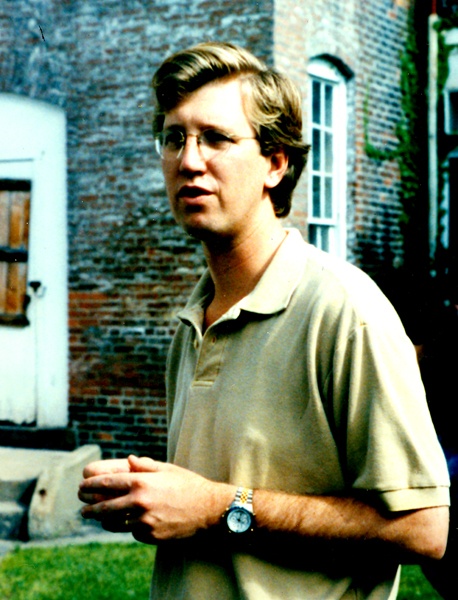Christoph Buchel Trashes Mass MoCA
A local artist offers an alleged preview of a stalled installation
By: Gregory Scheckler - Apr 02, 2007
After Carsten Holler's dopey Amusement Park, I was hoping for a total revamping of MASS MoCA's Building #5. But currently closed from view is Christoph Buchel's Training Ground for Democracy. Thanks to Geoff Edger's article in the Boston Globe "Behind Doors, a World Unseen: Dispute Cloaks Massive Installation at MASS MoCA" (March 28, 2007), some now know of a spat between the artist and museum. Cynics may speculate that such reports of scandal, and pervasive media coverage, create suspense. Will audiences be intrigued enough to visit out of curiosity when and if the confict is resolved and the exhibition opens to the public?
As a mostly unknown local artist, and professor at MCLA, in the shadow of world-class places like MASS MoCA, I've got some thoughts to share. From my vantage point way down here scraping the bottom of the art world where a thousand bucks is enough in materials and labor to make a poetic oil painting, it mystifies me that Buchel could command a quarter million dollars and still not get the job done. How is it possible that his collection of found-objects could be over-budget, unfinished, and not ready for view?
But first things first: we're told that the art is incomplete. Should you be able to see unfinished artwork? From my view these questions and Buchel's negative spin in the Globe article seem to be a distraction from the deeper question of whether or not Buchel's work is good art. Savvier artists simply view production problems and limits as challenges to creativity, asking the question 'how can I develop this artistic message, given this set of resources and this set of production schedules?' Are Buchel's complaints really about the art? No. Personally I have no sympathy for the whiner-darlings of the art world who are fortunate to have shows at major museums, and are coddled by top-tier galleries. Just what is all the fuss about and why do they believe in this guy enough to support his art?
Here's an alleged preview of the artwork and some spoilers. It is said that one enters the space through a fake ticketing lobby and then into the remnants of the old North Adams 6 cinema. That means plywood, cheap paneling, stained ceiling tiles, icky ruddy seats, and concrete blocks. Sure is ugly, but if you recall going to the old cinema, it's a little nostalgic too. And since it's in an art museum we get to think of the faked cinema as an artistic metaphor, but of what?
Perhaps what is beyond this transplanted movie theatre is the movie's contents, or alternatively, a make-believe but behind-the-scenes look at the world outside of a slickly edited Hollywood movie. Moving out of the fake cinema you might launch into the larger gallery space, filled with faked rooms housed in real sea containers. These rooms may have been mostly copied from low-resolution prints of digital photos scammed off news websites. One might also teeter atop a security tower, peer at a truck, a trailer home, some leaflet-bombs on a merry-go-round, and other detritus. The museum's publicity for the show states that the artist created an unblinking look at current events as seen through news media. But it seems like he just spent ten minutes online and picked out a few obvious pictures.
Even so, the use of media creates another layer between the sense of artful fiction and a tension between what is (or was) real and what is imagined. This recycling cpmprises large-scale found object art. That means some old junk has been found and then resituated or resuscitated as art in a museum. That's cheap.Or should be. It doesn't cost hundreds of thousands of dollars to purchase recycled trash. In fact. prior to the ongoing installation, the museum put out a call for donations of junk. Much of the content , arguably, represented free dumpster-diving. The most expensive acquisition of junk? A small, decrepit North Adams house has been reported by the Globe as purchased for $100,000, and then cut in pieces and reassembled inside the gallery. I don't understand why the house cost so much. I know more than a few people in the area who've purchased decrepit or abandoned, huge old Victorian houses for $75k or less. In any case, the house ate up almost half of Buchel's budget, which has been reported at $250,000.
Meanwhile, the museum's publicity includes news pictures of Arafat's compound in the West Bank; and other blatantly obvious hints at what satirist Jon Stewart's Daily Show calls 'Mess-o-potamia.' Thus the art is either local imagery recast through the lens of larger political problems, or, Buchel's take on current events through the lens of smaller local fields. This creates odd disconnects. But unlike fake-umentary comedy, Buchel's not joking. His garbage-aesthetic seems to be a serious artistic commentary on news media as related to a messy, often violent undergrowth of contemporary culture. Indeed, the darker sides of any form of government (democracy or not), and even of human nature itself, are always violence, destruction, and media propaganda. So it's not as if Training Ground's basic premise is an unusually insightful cultural critique of either global politics or of North Adams.
Buchel's installation may include a few misquotes, for example, a squished North Adams police car. This wreckage has been described as occuring when someone accidentally hit the car on Main Street, practically right outside the museum. That random event had nothing to do with politics, wars in the Middle East, or any political refugee camps. It was an accident, not a symbol. How then can this totaled cop car be misconstrued as somehow related to the difficulties of modern democracy, or somehow useful as any new fiction? I suppose if you don't know the history, you can ignore it. But locals who know the buildings, props, and cars, when and if this work goes on view, cannot merely disregard their actual history. Among these misappropriations, airheaded postmoderns might get caught thinking in circles about how Buchel's choices of subject matter are a doubling-up of real life with layers of gritty, punky, postmodern simulacra – but it's not 1980 and those circular, self-refuting, anti-aesthetic art theories are long since dead and gone. In fact, spoofing such simulations, on my office wall I have a copy of an old Weekly World News report "Idiot Art Collectors Mistake Plumber's Junk for Art." That's the fundamental problem with Buchel's garbage-aesthetic. It's ripe for comedy and a legitimate satire of the arts, but Buchel's just not amusing. Dada was funny. Duchamp was witty. Buchel's far too serious.
Given Buchel's taste for ugliness, it's also astonishing that this artwork is taking so much extra time. Why the delays? I have a guess: the artist's insane perfectionism that demanded the museum move this bit of trash an inch that way, paint that sea container a lighter shade of boring, hoist that building just so. Buchel's perfectionism is a completely unnecessary luxury. In the context of his garbage-aesthetic, audiences won't and probably can't notice minor design changes. Thus the old cliché: Looks like shit from the orchestra pit, but great from the second row. From a certain distance, some details just can't be noticed so practical artists don't bother with installing them. But Buchel apparently has nitpicked and micromanaged. Forgetting to scale the details, he squandered a lot of time and resources.
Ok, so the art is incomplete and it's unfair to criticize its content and industrial process just yet. This raises the question of just what's missing? You might fantasize, as I did, that the exhibit's faked cityscape might be a fun place to play paintball. Maybe to finish the art, the artist could install automated pop-up cutouts of space aliens that we could shoot at; curators could arrange for some helmets and paintball guns for museum-goers to use as they enter the exhibit. That way the artist could implicate and enact the audience's responsibilities related to today's crazy world. If not pop-ups, then maybe half a million Hot Wheels™ cars hanging on threads from the ceiling (they'll cost a dollar each – you'd better increase the budget – stop laughing! and how dare you compromise my artistic vision!) The Globe has quoted Buchel as saying there shall be no negotiation of his vision. That makes me wonder whether all parts of his artistic vision were worthwhile or even possible in the first place. I'm sure you could imagine any number of possibilities that would be edgier than the current exhibit. Buchel seems to think he has maore and better ideas. He is said to be in conflict with the museum because some of his ideas weren't included. But would any imagined additions to the art help the content, or balance it so that audiences can better experience the big picture? How do we know he's not proposing something stupid like my half million toy cars – and in such a case, wouldn't the museum have the right to say no? I predict Buchel's not coming back. His complaints are all bluster and no vision. He's toying with us.
Related to the artwork's pedestrian political stance, I think what's missing is what's most important in the context of assessing democracy, current events, and war: the beauty of a free press that can enrich what we can know of the world; discussion of the violent intolerance and elitism of so many religions and tribal rivalries in the Middle East; the nonviolent abilities of modern democracies that can overthrow bad political leaders by voting not killing; and, in cases of terrorism, the real compassion of people as they help each other survive these horrors no matter whose side they are on. Since the art so readily confuses reality for metaphor, I'm prepared to write off Training Grounds for Democracy as an unbalanced litany of Euro-leftist complaints, a manic propaganda that lacks humor and is supposed to be taken very, very seriously. Like so many political litanies, in the end it might turn out to be an empty media phenomenon hoisted up by witless complaints. Right now that's really all that it is, unless many people actually get to see the art. For that reason, I hope the museum opens the show, and soon.
I hope I'm completely wrong in these criticisms and that we'll all have a chance to make up our own minds once the show is open. It should be entertaining to see how the scandal plays out, because we're talking about top-tier meaningful art, aren't we?




